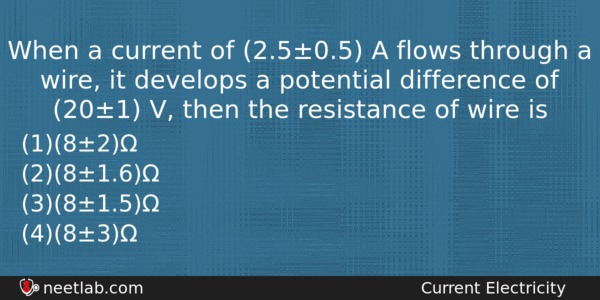| ⇦ | 
| ⇨ |
When a current of (2.5±0.5) A flows through a wire, it develops a potential difference of (20±1) V, then the resistance of wire is
Options
(a) (8±2)Ω
(b) (8±1.6)Ω
(c) (8±1.5)Ω
(d) (8±3)Ω
Correct Answer:
(8±2)Ω
Explanation:
No explanation available. Be the first to write the explanation for this question by commenting below.
Related Questions: - During negative β-decay
- Radiofrequency choke uses core of
- The radius of curvature of the convex face of a plano-convex lens is 12 cm
- Planck’s constant has same dimensions as those of
- A particle executes simple harmonic oscillations with an amplitude
Topics: Current Electricity
(136)
Subject: Physics
(2479)
Important MCQs Based on Medical Entrance Examinations To Improve Your NEET Score
- During negative β-decay
- Radiofrequency choke uses core of
- The radius of curvature of the convex face of a plano-convex lens is 12 cm
- Planck’s constant has same dimensions as those of
- A particle executes simple harmonic oscillations with an amplitude
Topics: Current Electricity (136)
Subject: Physics (2479)
Important MCQs Based on Medical Entrance Examinations To Improve Your NEET Score
18000+ students are using NEETLab to improve their score. What about you?
Solve Previous Year MCQs, Mock Tests, Topicwise Practice Tests, Identify Weak Topics, Formula Flash cards and much more is available in NEETLab Android App to improve your NEET score.
Share this page with your friends

R=V/I
R=20/2.5
R= 8 ohm
Now,
∆ R/R=∆ V/V+∆I/I
=1/20 +0.5/2.5
= 1/4
Therefore,
∆ R÷R=1÷4
∆ R=1÷4×R
∆R=1÷4×8
∆R=2
Therefore,
Resistance with error limits=R+ – ∆R
=(8+ – 2)ohm